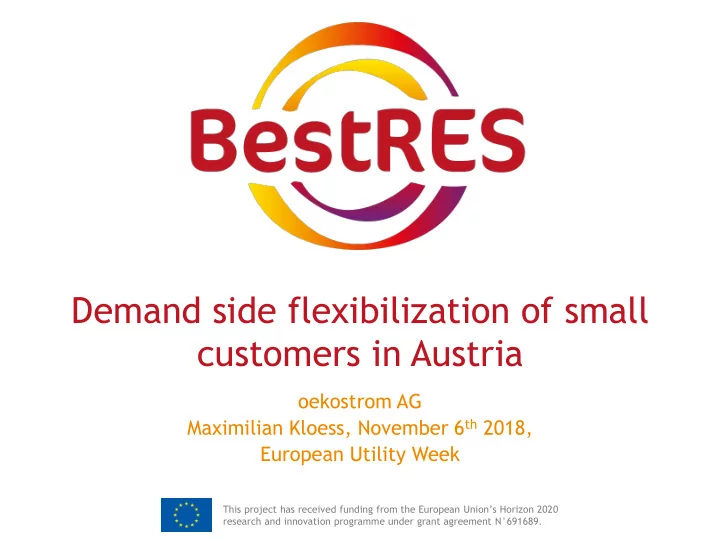

Demand side flexibilization of small customers in Austria oekostrom AG Maximilian Kloess, November 6 th 2018, European Utility Week This project has received funding from the European Union’s Horizon 2020 research and innovation programme under grant agreement N°691689.
The Concept of Variable Tariffs
The concept of variable Tariffs Variable tariffs ( or time of use tariffs) • Are tariffs, where the power price of the customer depends on the time when the power is consumed during the day • Currently applied for most power producers and large consumers Application for small customers requires smart meters • fixed tariff variable tariffs e.g. two zones spot-prize-dependent price price price 1 2 3 4 5 6 7 8 9 10 11 12 13 14 15 16 17 18 19 20 21 22 23 24 1 2 3 4 5 6 7 8 9 10 11 12 13 14 15 16 17 18 19 20 21 22 23 24 1 2 3 4 5 6 7 8 9 10 11 12 13 14 15 16 17 18 19 20 21 22 23 24 time time time 04/12/2018 3
The concept of variable Tariffs Economic motivation to apply variable tariffs • Incentivize system-beneficial consumer behaviour: – consume more power when there is much available – consume less power when power is scarce → Flexibilization of power demand • Important for fluctuating renewable power integration More fluctuation on the supply side requires more flexibility/elasticity on the – demand side. Inelastic demand: price elastic demand: price renewables renewables load load price price load load 04/12/2018 4
Customer Survey on Variable Tariffs
Customer Survey on variable tariffs In March 2018 oekostrom conducted a survey on variable tariffs among their customers. Customers addressed: 17.000 Customers participating: 1.000 Content: demographic data • housing situation • • Knowledge and attitude toward smart meters & variable tariffs 04/12/2018 6
Customer Survey on variable tariffs Selected results: 49% 44% How do you live? 7% Family house Semi-detached Apartment house building 85% Do you operate a photovoltaic system at your primary residence? 15% Yes No 98% Have you already installed a battery storage in your household? 2% Yes No 61% Has your primary residence already been equipped with a smart meter? 20% 19% Yes No Don´t know 04/12/2018 7
Customer Survey on variable tariffs Selected results: 71% 29% Have you dealt in the past with the topic of time-variable electricity tariffs? Yes No 76% Regardless of the specific design of a time-varying 24% electricity tariff, which of the following statements I can well imagine A time-varying is more applicable to you? the use of a time- electricity tariff is out variable electricity of the question for tariff me 51% Now that you've assessed some of the benefits and 30% concerns of time-variable tariff, do you think you 11% could personally benefit from such a tariff? 7% Strong Slightly Less Not at all As soon as oekostrom AG puts a time-variable 71% electricity tariff on the market, I would like to be informed of this with a separate letter. 29% Yes No 04/12/2018 8
Variable Tarif Design & Implementation
Variable Tarif Design & Implementation oekostrom developed a time variable tariff to be offered to all customers who have a smart meter available Tarif Design: • Monthly basic charge • Power pricing based on Austrian day-ahead spot prices (www.exaa.at) • Fixed fee on top of the power price • Visualization of consumption and power prices in the customer portal. • Monthly billing of actual consumption at the realized prizes 04/12/2018 10
Variable Tarif Design & Implementation customer number oekostrom customer portal: metering data section DSO meter number power prices tarif facility monthly number bill load 04/12/2018 11
Variable Tarif Design & Implementation Implementation Plan: • Preperation Phase: – Setup of data exchange interface to the DSOs (according to customer processes defined for the Austrian market) Setup of process to obtain the customers’ declaration of consent for forwarding their – consumption data from DSOs to the supplier (EU General Data Protection Regulation) Adaptation of billing system for hourly & quarterly resolution of quantities and prices – Adaptation of customer portal to visualize power prices and load – • Testing Phase: up to 50 selected pilot customers – Testing of data exchange process with DSOs – Testing of declaration of consent process for data use – Testing of billing process Customer feedback – • Market Introduction – Product launch 04/12/2018 12
Regulatory & Practical Barriers
Regulatory & Practical Barriers DSOs lack behind with their smart meter rollout • DSOs lack behind with the implementation of the data interface and • the data exchange process (defined in the “customer processes”). • Process has to established one by one with over a hundred DSOs in Austria No clear regulatory standard is defined • how the customer declaration of consent on data use has to be handled (interpreted differently Supplier by each DSO) • Currently automatization of handling of customer processes is not feasible data use permission data forwarding process DSO smart meters Consumer Consumer Consumer 04/12/2018 14
Summary & Outlook
Summary & Outlook Experiences: High interest for variable tariffs among customers • • Consumption data visualization creates awareness for power consumption Challenges: Unexpected changes in the regulatory framework conditions (smart meter • roll-out schedule, EU General Data Protection Regulation) Slow smart meter roll-out is a major barrier to large scale application • Data exchange with DSOs still to be established and standardized (metering • data; customer declaration of consent for data use…) Data protection • Outlook: • Variable tariffs can lead to cost-savings for customers and suppliers Variable tariffs pave the way for further smart services and applications • 04/12/2018 16
Thank you for your attention! Dr Maximilian Kloess oekostrom AG maximilian.Kloess@oekostrom.at
Recommend
More recommend